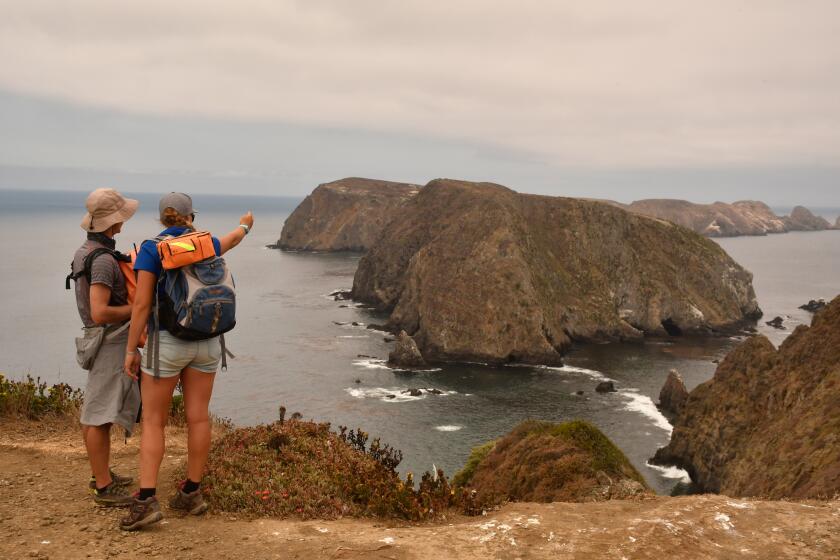L.A.’s Winston Street has a colorful history
- Share via
In downtown L.A., Winston Street has a history.
There was the mysterious puddle of blood, and a baby stuffed in a cigar box in the late 1800s. Bodies have been tossed into dark corners, and there were the decades addicts and alcoholics spent in the dingy alley shooting up, drinking and fighting. Just a few years ago, hypodermic needles, discarded crack pipes and prostitution were not an uncommon sight.
But these days, demand for apartments on Winston Street is high. It’s transformed into something of a gritty outdoor gallery at the edge of skid row, where wholesale suppliers and sidewalks cluttered with mannequins and umbrellas give way to trendy bars and lofts.
Trash still crowds the edges of the place some know as Indian Alley, but the spirit of the area and its inhabitants has exploded onto its walls, the sides of buildings, utility boxes on neighboring streets, and the sidewalk that connects two distinct downtowns.
More than a dozen murals have been painted under the unofficial stewardship of Stephen Zeigler, who moved into the broken, alley-adjacent building at 118 Winston St. in 2008. He cleaned the streets when no one else would, wrote positive messages on the walls, and painted the street poles gold. Curiosity about his home’s past has turned him into a sort of historian-in-residence.
Built in 1887, the building was one of L.A.’s premiere piano shops, a brothel, and the headquarters of a youth communist society and the International Labor Defense before the 1950s, according to Times archives. Sister Sylvia May Cresswell, once crowned “Queen of Skid Row,” ran her “Soul Patrol” there during and after World War II. The building had a cameo in the film “The Sting.”
Then, starting in the 1970s, it was the United American Indian Involvement center, opened to provide a safe place for American Indians to clean up, get a hot meal, and escape the harassment they encountered, said Dave Rambeau, director of the rehab center for more than 30 years.
Workers there saw mothers who stored needles in baby bottles, stabbings and conflicts with law enforcement, and cared for alcoholics they could never change. The morgue called them to help identify the American Indians who died on the streets. The center hoped to fill basic needs when it first started, Rambeau said, and has since grown into a comprehensive health and services center aiding the county’s sizable American Indian population.
A meal and a sense of security are what Sidney Newton remembers of the hazy days he spent there in 1991. He came back to find the part of himself he left in the alley when he was an alcoholic. It all looks different now, he said, cleaner. Since the center moved in 2000, the building has housed a yoga studio, art gallery and residence.
A few years ago, the tiny street was dead and dark, and attracted a crowd some might fear, said Kevin Khakshouri, manager of 117 Winston. Now, streams of passersby stop to take photos in front of a colorful mural of Audrey Hepburn painted on the sandwich shop at the corner or slow down to angle their cameras through the iron gate at the mouth of Indian Alley, marked by a faux street sign.
The block isn’t perfect. A recent timelapse of the building showed a young night crowd posing for photos next to an art installation, urine pooling on the sidewalk, a man smoking a joint before nodding off to sleep against the wall. In the daylight, two men wrap their arms tight with the strap of a messenger bag before they settle on the porch steps.
But the art has helped put the block on the map and has injected a sense of community and life, said Khakshouri, whose building, the Jeffries, was renamed last-minute after Zeigler imparted a bit of neighborhood history. The murals have crept around the corner, too. Recently painted portraits of two women in blue facing Los Angeles Street spread a bit of that energy and draw people down Winston, he said.
The art is the same for the homeless man pushing his cart and camping out on Los Angeles Street or the guy slowing down in the $100,000 car. It makes people stop and stare because it’s beautiful and playful, and brings a different kind of attention to a cause than screaming and stamping feet, said Zeigler, a photographer. He realized the possible impact after working with street artists Wild Life and Calder Greenwood to place a sunbathing, papier-mache family in an empty downtown lot in 2012.
Now the alley resembles a street in Europe or South America, said Isabel Rojas-Williams, executive director of the Mural Conservancy of Los Angeles.
Bricks, both painted and plain, blend with faces of Native American figures including Robert Sundance and Toypurina. Symbols of peace, Buddhism and social justice fade into messages that commemorate American Indian history. A man leading a horse under the words “We are still here” peeks out of the alley, a piece painted by popular street artist Shepard Fairey. A cardboard boat rests on a weathered fire escape.
Zeigler, who feels a strong connection to the building and its history, has sought out local artists and those with American Indian ties to cover the walls, part of the reason the Mural Conservancy has started leading tours of the area.
Smaller than one of its typical routes, the concentration of art and the blend of history and messages that inspired the work are what make it special. It’s like the city. Los Angeles is more than cafes and bars, Rojas-Williams said, and people should remember that when they visit.
More to Read
Sign up for Essential California
The most important California stories and recommendations in your inbox every morning.
You may occasionally receive promotional content from the Los Angeles Times.














